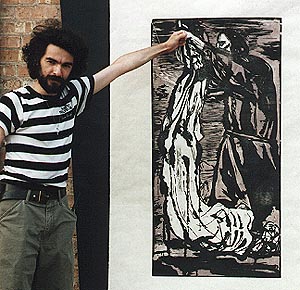Paintings that are like precious stones, crystals, mosaics of Byzantium, like Persian rugs, stain-glass windows, like icons and their covers of gold, paintings that grow like flowers, starting with a tiny seed at the upper left corner and developing into a composition, gradually, by themselves.
Similar results were achieved by Mikhail Vrubel (early 20th century artist who used drawing as a process of crystallization), Pavel Filonov (early 20th century artist noted for his theory of "Universal Flowering"), and other artists of the Russian Avant-Garde -- Malevich, Chagall, and Larionov -- who were influenced by the icon-painting, folk art and crafts, popular prints, and idols of the ancient time in Russia and Orient. These artists belonged to the avant-garde triangle, Moscow-St.Petersburg-Vitebsk, and which laid a basis for Belarusian Art.
My artworks are a bridge, a way to connect the past with the future, links in the chain of the history of Belarusian Art -- offerings for the altar to this art's Renaissance. Specificially, each of these paintings and prints is a thing in itself and simultaneously an inseparable segment in chain of creation. A painting contains all the future works and those that were never painted. It is especially true of prints. They are shadows of unrealized paintings, memories of past time. This is an attempt to reconstruct the forgotten language, the sound of it and not the symbols. It is yet another hypothesis of how world began, and how it will end. It would be easier to understand these works if one knows the language of either the past or the future. There is nothing of the present in them. The paintings are meant to be recited. Prints on the contrary are to be whispered.
-- Anatole Upart
